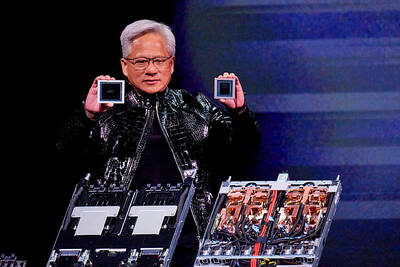E Ink Holdings Inc (元太科技), which supplies e-paper displays for Amazon.com Inc’s Kindle e-reader series, yesterday reported a widening net loss of NT$1.01 billion (US$33.63 million) for last quarter because of slack demand for e-paper displays and LCD panels.
The quarterly net loss represented a deterioration from the first quarter’s net loss of NT$492 million and a net loss of NT$818 million in the second quarter of last year, the company’s financial statement showed. That also marked the worst quarterly loss in about four years.
Last quarter, E Ink also booked a one-time severance payment of NT$500 million for a 50 percent workforce layoff at its South Korean LCD manufacturing subsidiary Hydis Technologies Co. The number of Hydis employees has been halved to about 400 from between 800 or 900 before the personal adjustment, E Ink said.
Meanwhile, the Hsinchu-based company said it received a record high royalties fee at NT$400 million by licensing Hydis’ patents to Sharp, LG Display and other panel makers to make high-resolution LCD panels that are partly used in Apple Inc and Samsung Electronics patents.
E Ink was upbeat about this quarter’s prospects.
“Customers have put off their new product launches to the third quarter from the second quarter,” company chief financial officer Eddie Chen (陳彥松) told investors.
“There is enormous growth momentum to arrive in the third quarter. You will feel the [strength of] an upswing,” Chen said.
This quarter, revenue is expected to at least double last quarter’s NT$2.93 billion, as customers were scheduled to ship new e-readers for the holiday shopping season, Chen said.
E-paper displays made up about 70 percent of the company’s overall revenue last quarter, according to E Ink.
Gross margin would rise further from last quarter’s 7.1 percent and 5 percent in the first quarter, as the company would ship more higher-margin e-paper displays, Chen said.
To reduce the impact of tablets, E Ink is seeking new growth areas in developing new e-paper applications such as displays for digital magazines, smart watches, handset covers and luggage tags.
By the end of this year, e-paper for those new applications are expected to make up less than 5 percent of the company’s overall revenue, Chen said.
Overall e-reader shipments are expected to be flat at a range between 10 million and 15 million units, compared with last year, E Ink said.
E Ink shares fell 1.23 percent to NT$16.1 yesterday, underperforming the TAIEX, which was down 0.81 percent.

Nvidia Corp chief executive officer Jensen Huang (黃仁勳) on Monday introduced the company’s latest supercomputer platform, featuring six new chips made by Taiwan Semiconductor Manufacturing Co (TSMC, 台積電), saying that it is now “in full production.” “If Vera Rubin is going to be in time for this year, it must be in production by now, and so, today I can tell you that Vera Rubin is in full production,” Huang said during his keynote speech at CES in Las Vegas. The rollout of six concurrent chips for Vera Rubin — the company’s next-generation artificial intelligence (AI) computing platform — marks a strategic

Enhanced tax credits that have helped reduce the cost of health insurance for the vast majority of US Affordable Care Act enrollees expired on Jan.1, cementing higher health costs for millions of Americans at the start of the new year. Democrats forced a 43-day US government shutdown over the issue. Moderate Republicans called for a solution to save their political aspirations this year. US President Donald Trump floated a way out, only to back off after conservative backlash. In the end, no one’s efforts were enough to save the subsidies before their expiration date. A US House of Representatives vote

REVENUE PERFORMANCE: Cloud and network products, and electronic components saw strong increases, while smart consumer electronics and computing products fell Hon Hai Precision Industry Co (鴻海精密) yesterday posted 26.51 percent quarterly growth in revenue for last quarter to NT$2.6 trillion (US$82.44 billion), the strongest on record for the period and above expectations, but the company forecast a slight revenue dip this quarter due to seasonal factors. On an annual basis, revenue last quarter grew 22.07 percent, the company said. Analysts on average estimated about NT$2.4 trillion increase. Hon Hai, which assembles servers for Nvidia Corp and iPhones for Apple Inc, is expanding its capacity in the US, adding artificial intelligence (AI) server production in Wisconsin and Texas, where it operates established campuses. This

US President Donald Trump on Friday blocked US photonics firm HieFo Corp’s US$3 million acquisition of assets in New Jersey-based aerospace and defense specialist Emcore Corp, citing national security and China-related concerns. In an order released by the White House, Trump said HieFo was “controlled by a citizen of the People’s Republic of China” and that its 2024 acquisition of Emcore’s businesses led the US president to believe that it might “take action that threatens to impair the national security of the United States.” The order did not name the person or detail Trump’s concerns. “The Transaction is hereby prohibited,”